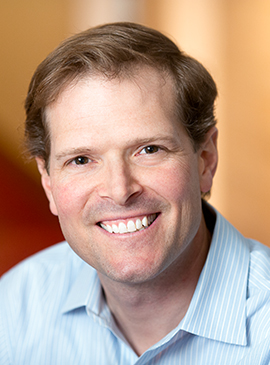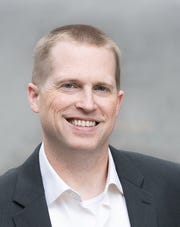The Impact of People Analytics at Genentech

The recently released report from the ROI Institute and the Institute for Corporate Productivity (i4cp), Four Ways to Advance Your People Analytics , examines workforce analytics advances, trends, barriers, and more. It includes four key recommendations to advance organizations’ people analytics function based on data collected from hundreds of organizations and a dozen interviews with people analytics leaders:
- Focus on talent on the team
- Integrate far and wide
- Invest in technology and tools
- Build trust through incremental success
One of the leaders interviewed as part of this study was Chase Rowbotham, Head of People Analytics at Genentech. The experience and insights he shared with i4cp spanned all four of these key practice recommendations and more, and includes an example of a very successful analytics project. What follows is part of that interview.
Could you describe briefly how the people analytics function is structured at Genentech? What are some of the key roles?
 In less than three years, the people analytics function at Genentech has nearly tripled and already has had real impact on the business. As head of people analytics, I report directly to the CHRO, and my team of around ten people includes two primary functions:
In less than three years, the people analytics function at Genentech has nearly tripled and already has had real impact on the business. As head of people analytics, I report directly to the CHRO, and my team of around ten people includes two primary functions:
- Data science & engineering
maintains the people analytics infrastructure and creates tools to deliver consumable people analytics. This team also designs experiments, builds the code base, performs statistical analyses, and fits models to drive meaningful and actionable insights.
- Strategy & solutions
plays the front-end role on the team and leads project scoping, prioritization, stakeholder management, project management, and ensures that product strategy is both effectively communicated and realized. This team also leads and facilitates strategic planning for all of Genentech’s HR organization.
How have you gone about building out the team?
My focus has been on finding the best individuals for each role, irrespective of their HR experience. I didn’t set out to hire people from outside of HR, but I did want people with advanced experience and degrees in their key areas of expertise, and I knew that people could learn HR along the way. For example, I hired our data engineering lead internally from the product development team at Genentech. She used to help manage clinical trial databases. She moved over to HR where she could apply a similar set of skills and capabilities, but do so in a different context. In fact, she has since moved on to lead data engineering for our diversity and inclusion team, which is fantastic. I love how analytical acumen is proliferating across HR.
What are some advantages of this approach?
This approach has worked because the team is surrounded by people who have decades of HR experience, so there are many colleagues to learn from (and a reason to collaborate and have conversations). I think one of the values that my team brings is a very objective view of the world. None of us have come in with ten years of performance management expertise, or ten years of total rewards expertise, or ten years of career coaching experience. We are very data driven. We assume nothing. And we ask a lot of questions.
Have there been any challenges with this approach?
The team has given HR a strong data position to stand on, but there can be discomfort when long-held assumptions or practices are questioned. So, it is important that we are empathetic and listen as we engage in these kinds of conversations. For me, a key has been sitting on the HR leadership team. It allows me to be at the table when important discussions occur or when decisions are made. It also sends a signal to the broader organization that analytics matters.
When I arrived at Genentech, we largely executed reporting and did so very manually. But over time, we have transitioned to focus on advanced analytics and data science. We want to build data acquisition and decision support tools that are both automated and scalable, and also relevant inside and outside of Genentech. We also lead strategic planning for HR. At Genentech, people analytics is not an exception. It is an expectation and it is integrated into how we make decisions, how we show up to customers, and how we create actionable insights.
Can you give us an example of a successful project that People Analytics has undertaken, and describe how it impacted the business?
Genentech’s business is based on innovation: we aren’t a generic pharmaceutical company. Rather, we are an innovative biotechnology company that tackles unmet patient needs. We’ve long held the view that cohabitation is critical to driving collaboration and innovation—the kind of innovation that impacts patients. We also happen to be located in the San Francisco Bay Area, a region that has experienced strong economic growth and job creation. A byproduct of this success has been crowded infrastructure and subsequently, there has been increased frustration from many of Genentech’s employees.
So, the people analytics team decided to investigate. We started by asking: How might we quantify and codify this problem? We had employee addresses, but we didn't know how long it takes employees to travel to work each day. But other companies have this information. So, we leveraged Google’s API and were able to validate our hypothesis that the average commute time had increased—in fact, it had nearly doubled over the last 15 years.
Not only was infrastructure more crowded, but people had also migrated farther away from our South San Francisco campus. We now had objective data proving what had previously been expressed anecdotally.
Very interesting. What was the reaction when you shared these initial results?
When the CEO and executive team were shown the results, they became increasingly curious and so the team pressed forward and connected these findings with turnover data. We basically created a survival model. That is, a similar analysis that we leverage to understand the efficacy of our medicines relative to the current standard of care. We categorized our employees into one-way commute increments of 15 minutes, for instance 0-15 minutes, 16-30 minutes, and so on. What we discovered was that employees who had one-way commutes of 45 minutes or more had higher turnover rates.
Fascinating. What happened next? Did this lead to changes at the organization?
Given this specific finding, the senior team started thinking about what could be done. We have ended up trying several things that respect the need for the company to innovate, but provide employees with support and flexibility. First, Genentech created a comprehensive working flexibly framework that was rolled out in Q1, 2018. Genentech now provides managers with tools to support having conversations with their teams to establish team norms and approaches that embrace working flexibly.
Second, Genentech is experimenting with alternative commute options to help alleviate the strain of commuting to Genentech headquarters during peak commute hours. For instance, we have invested in some high-speed ferryboats as an alternative to using the high-traffic routes and bridges. We also created drop-in centers that have some key technology so people in some roles can work and be productive from those locations. And there are buses that link those drop-in centers with headquarters to maintain a connected campus. These experiments are still in their early phases, but we believe they will allow our employees to do their best work.
This is a great example of a thorny problem, one that touched on some cultural aspects of the organization and required integrating data from multiple sources and building trust from incremental success over time.
Yes, we didn't just use a bunch of anecdotal stories. We took a very scientific approach to the problem. That is what people analytics is: our mission is to improve individual, team, and organizational success by developing hypotheses, running experiments, and using data and analytics to drive better decisions that ultimately lead to more success.
In terms of incremental success, we take a minimum viable product (MVP) approach to the tools that we roll out to customers. Not only does this help us validate our tools to make sure that they are useful, but it also allows customers to drive our roadmap and subsequent features and functionality. This also helps transition “ownership” of our tools from people analytics to our customers.
You are already accomplishing a lot, but if you were to look ahead a couple of years, what is your vision for people analytics at Genentech?
We want data analytics to inform all people decisions. We don't and can’t capture everything about people in data. We can't represent with data what doesn't exist yet. But we are getting to a point where our insights are read and on-demand for managers, for employees, and for leaders of the organization to consume when they need it.
Tell me where my team is strong, tell me where my team has opportunity, tell me what I can do about it, and most of all, tell me why it matters. Ultimately, we want to not just drive insights, but to drive action—to drive positive team changes that improve people and business outcomes. That is the business that people analytics team is in: driving better people and business outcomes.





